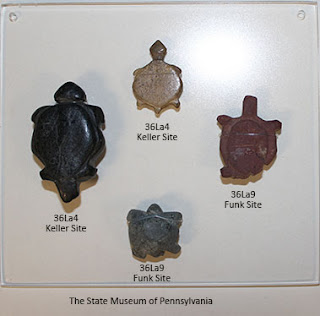As we enjoy this beautiful summer weather, walking or
driving down country trails and roads, be sure to keep an eye out for turtles. Turtles have been revered by cultures around
the world. They are often viewed as wise
beings, symbols of longevity, messengers between this and the spirit world or
as some northeastern indigenous people believed in the creation of our world on
Turtle Island. Many eastern tribes,
including the Lenape and Iroquois, had similar creation stories. They believed that in the beginning the world
was covered entirely with water. There was an island in the sky where the Sky
People lived. No one died or was born
there, and all was well. Until Sky Woman
fell through a hole toward the sea where she landed on grandmother turtle or Turtle
Island. Various water animals took turns
diving to the bottom of the sea trying to bring mud to spread on the turtles
back. Eventually one succeeds (depending
on the version of the story as to which animal succeeded), but they did and when
placed on the turtle’s back it created land that grew and grew eventually
becoming the size of North America. This
over simplification of the creation story is derived from several versions and
from several tribes, this and in other legends about turtles can be found here.
Turtles appear repeatedly throughout native legends
demonstrating their relevance to human society.
This respect is recognized in the archaeological record by the many pendants,
ornaments and effigies discovered on Northeastern sites. Kinsey (1989) suggests that reptiles “constitute
15% of the Susquehannock [study of zoomorphic images] sample and less than 4%
of the Seneca sample and these are limited to turtles and snakes; the former is
the most common”. In Pennsylvania,
turtle pendants are more prevalent than pipe effigies, but there have been several
found in other states.
There is a very interesting pendant that was recovered from
the Flint Mine Hill site in New York.
This site is described as “a vast industrial complex consisting of numerous
quarry pits, quarry and production refuse piles, small campsites, and extensive
workshops where chert was knapped” (Lenik, 2010). The pendant depicts a turtle surrounded by a
snake and is carved on both sides. Suggested
interpretations are that it is an amulet meant to drive away demons by
depicting a snake devouring another animal (Parker, 1925) or as perhaps the
snake invoking a guardian spirit to protect the wearer who was of the turtle
clan (Lenik, 2010)
Not only are turtles represented on portable artifacts, but
they are also found as petroglyphs and as effigy rock features. Petroglyph sites in Pennsylvania, Ohio and
West Virginia were documented by James Swauger, many of which exhibit designs
interpreted as turtles.
There are also several examples of effigy rock features in North
Dakota and the Lake of the Woods region of Canada.
It is clear that turtles have been revered by indigenous
people since at least the Archaic period (Pearce, 2005), by the variety of specialized
images presented. Physical turtle shells
are also represented in the archaeological record. Their shells were used as utilitarian objects
like bowls and scoops.
They have been
found in ceremonial contexts like the burials at Serpent Mound, where unmodified
turtle shells were found next to human skeletal remains (Pearce, 2005). Rattles made of turtle shell have been found
on numerous sites and are ethnographically documented in ceremonial use, such
as the False Face Society.
Turtles have been esteemed by cultures around the world, so
it is no surprise that Native Americans respected this now often-overlooked
creature as well. So, keep in mind the
special turtle as you explore mother nature this summer and if by chance you
see one along the roadside maybe give this noble creature some respect and if
safe, a hand in crossing.
Kinsey, W.
Fred
1989 Susquehannock Zoomorphic Images: Or Why
the Seasons Change. In New Approaches to
Other Pasts edited by Fred W. Kinsey
and Roger W. Moeller. Archaeological Services, Bethlehem, Connecticut
Lenik, Edward
J.
2010 Mythic Creatures: Serpents, Dragons, and Sea
Monsters in Northeastern Rock Art. Archaeology of
Eastern North America 38:17-38
Parker, Arthur
C.
1925 The Great Algonkin Flint Mines. Researches and Transactions of the New York
Archaeological Association.
4(4):105-125
Pearce,
Robert J.
2005 Turtles from Turtle Island: An
Archaeological Perspective from Iroquoia. Ontario
Archaeology 79/80:88-108
Swauger,
James L.
1974 Rock Art of the Upper Ohio Valley.
Akademische Druck- u. Verlagsanstalt, Graz, Austria
For more information, visit PAarchaeology.state.pa.us or the Hall of Anthropology and Archaeology at The State Museum of Pennsylvania .

















